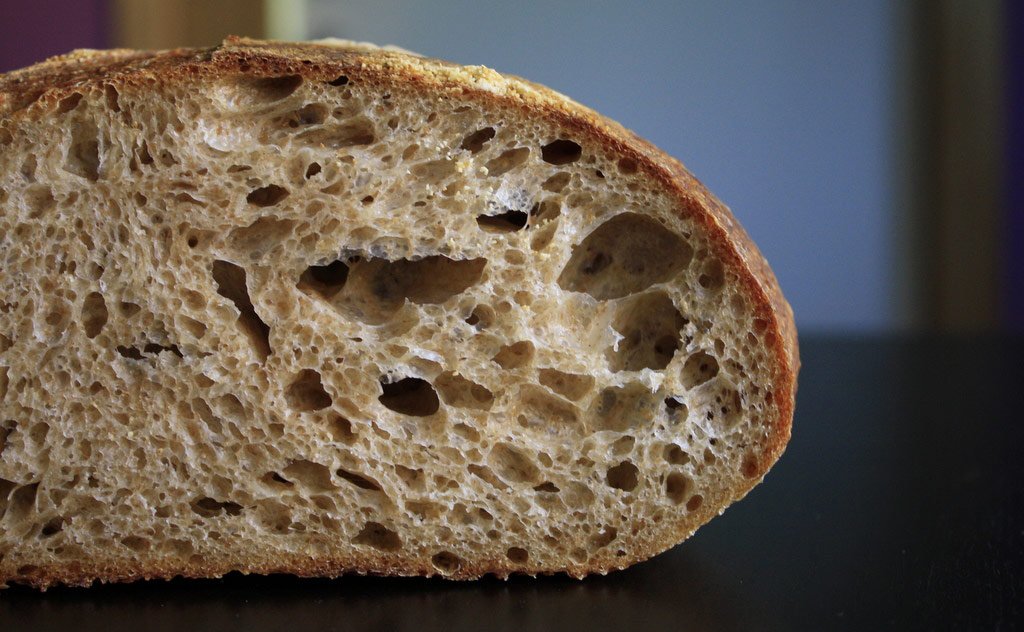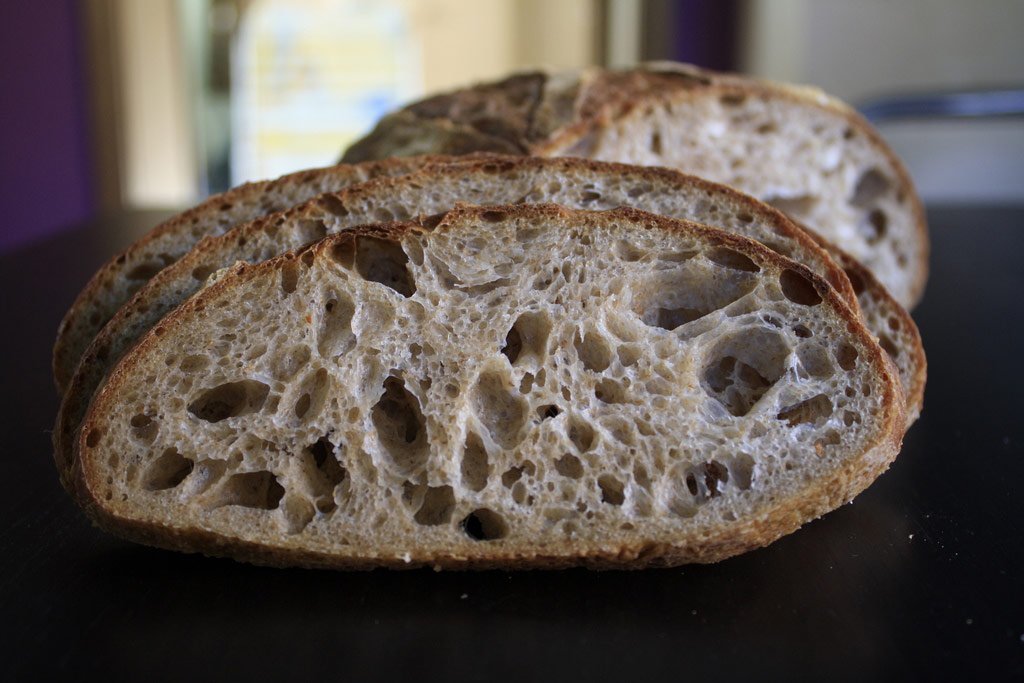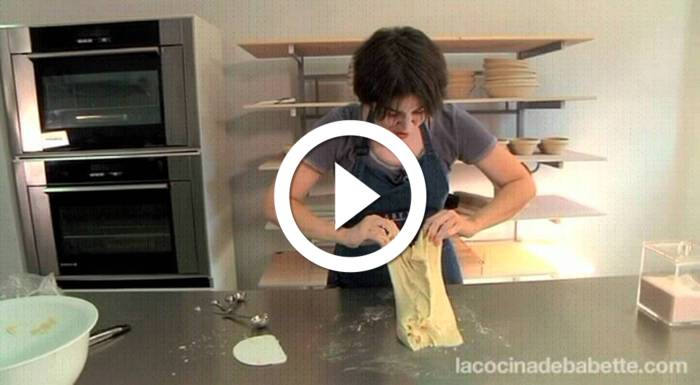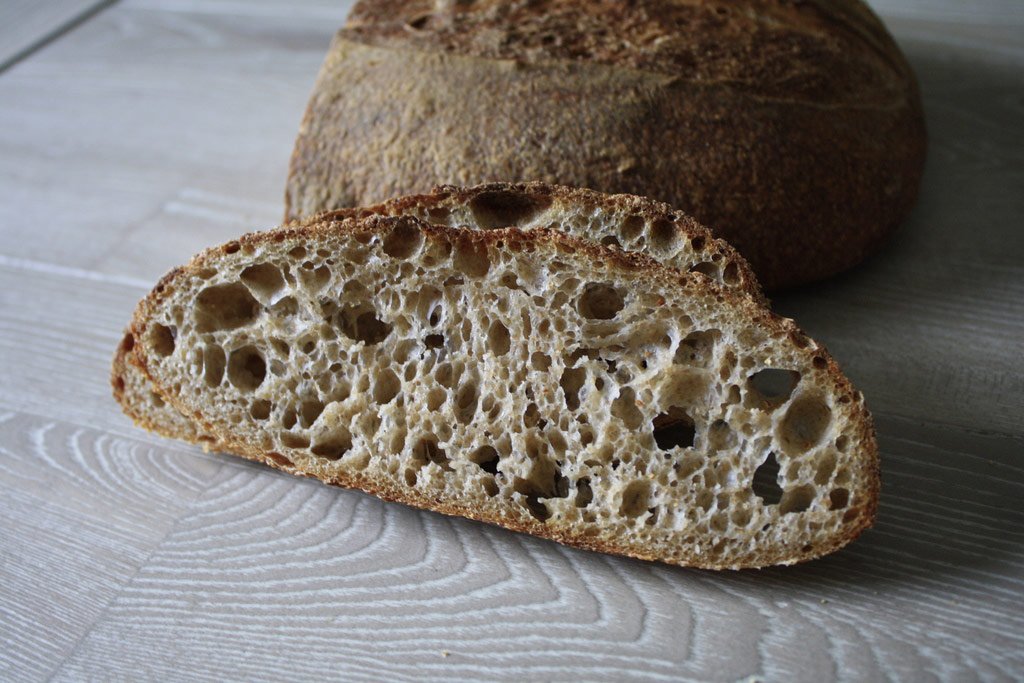The possibilities with bread baking are endless. If you’re starting with baking or you’d like to experiment with it for a while, like I do, it’s usually a good idea to stick with one basic formula and extend from there. That way, you can more easily compare the results and you get to learn one way of bread baking very well. This one formula you’ll be baking regulary is called “your daily bread“.
After baking for a few months and trying out different recipes from various books, I settled with my daily bread as a morphed version of Mr. Hamelman’s “Pain au levain with wholewheat” recipe. Why? Because it’s one of the simpler sourdough no-fail breads I’d like to master. I did obviously tweak it to my taste.

My daily bread – the recipe
preferment (15%)
- 145gr. stone-ground organic wholewheat flour (got at a local mill)
- 10gr medium rye flour
- 145ml water
- 2 tablespoons of your starter (mine’s a white wheat 100% hydratation one)
The original recipe called for a white flour preferment, but I like the wholewheat taste and as we all know, it’s a lot mure nutritious!
final build
- 605gr high-protein flour (all-purpose bread flour will do nicely, I didn’t have any at this point)
- 40gr medium rye flour
- 200gr wholewheat flour (also finely stone-ground)
- 1 tablespoon of salt
- 590gr water
- the preferment
What did I change in the original recipe? As you might have noticed, completely replaced the bread flour with wholewheat in the preferment and upped the water amount by a bit. (As you might know, wholewheat flour soaks up more water, and I like holes in the bread, which is caused by a high hydratation percentage)

Method
day 1, morning
6:00 AM – Combine all the ingredients for the preferment and mix into a thick paste. Let it stand and rest at your kitchen counter for about 12 hours (my kitchen was 24°C at that time.)
day 1, evening
6:00 PM – Combine the rest of the ingredients except the preferment and the salt. No need to knead yet, just let it stand for about 30min – an hour. This is called “autolyse“, a method to precreate some gluten and to reduce the kneading time.
6:30 PM – add the preferment and salt to the rest. Now it’s time to mix. I always knead by hand (artisan baking all the way!). Traditional breads with yeast require some thoroughly kneading for 10 minutes or more, but this is not needed thanks to the preferment, the autolyse phase and the long fermentation phases after this.
The most helpful video on **french fold **style kneading would be this one:

“french folding” is a term coined by Richard Bertinet – you can watch him doing and explaining the same technique in another YouTube video (dubbed in Spanish). If you don’t want to do this, you can simply mix with a spatula and knead on the kitchen counter as you’re used to but due to the high percentage of water in the dough this will not be easy. Mechanical kneading does not suffer from the same drawbacks when using high hydratation doughs but it’s not as much fun, isn’t it?
Knead max. 5 minutes (might take longer the first try! Don’t worry, as soon as you can see your dough *developing*, you’re fine) and cover the mixing bowl to let the dough bulk ferment.
7:15 PM – do your first “stretch & fold“: take the dough out of the container, stretch it a bit (without degassing it too much) and fold it like a letter over itself in 2/3th. Turn it 90° and do the same. We’ll do this twice within the 2 hour bulk ferment to strengthen the dough as high hydratation dough is quite slack and otherwise it’ll lose it’s shape when proofing.
8:00 PM – next stretch & fold.
8:30 PM – the dough has been rising for 2 hours now, time to preshape. Take it out of the container onto a dusted workbench, divide & shape your dough however you’d like. (A boule would be nice). Let it rest (cover with plastic to prevent a crust from forming!).
8:35 PM – the dough had some time to rest, let’s reshape it again. Put the shapes in a proofing basket if wanted and immediately transfer them to the fridge where it’ll sit for 24 hours.
day 2, evening
8:15 PM – preheat the oven at 250°C.
8:35 PM – take the proofed loaves out of the fridge and transfer them to a baking sheet. If you have a pizza stone you’re lucky (and you might need to preheat the oven longer!). Slide them into the oven and apply some steam using a plant mister.
8:40 PM – quickly spray the oven for a second time to create more steam.
9:10 PM – check on the loaves: if the crust is darkbrown and you hear a hollow sound while knocking on the bottom of the breads, they’re done, yay! Let the loaves cool on a cooling rack and try not to touch them until completely cooled down.
11:00 PM – You may now taste your creation (or wrap them in linen or a towel and eat a piece for breakfast, that might even be a better idea).
The taste was not very sour at all, very mild, and the texture, as you can see, was amazing. I love the open structure of the crumb! The slices of bread are still a bit sticky, because the bread is at **71% hydratation **and has 65% wholewheat flour in it.
To get a more sour taste, I’m trying out more experiments which I will post under the learning category. My first experiment was retarding longer in order to get a more pronounced flavor.

The experiment results are just in:
Retarding longer does not increase the sourness of your bread. It even reduces it at some point, and creates a more slack dough.
The loaves were proofed in a basket and shaped in the same way, but the latter one was noticably more flat as I put it on the baking sheet. It has clearly been overproofed. There are threads enough at The Fresh Loaf containing similar experiments, which indicate the following:
- retarding in the fridge at lower temperatures gives your bread a milder instead of more sour taste.
- retarding for more than 40 hours is not done unless you add a very small amount of preferment to the final build. For 15%, this is really the maximum.
- The Lactic Acid Bacteria (LAB) in the sourdough starter are responsible for the sour taste (not the smell) and thrive in more wet and warm conditions. Therefore, your preferment should be at least at 100% hydratation (or possibly more?)
Time for more experiments!
